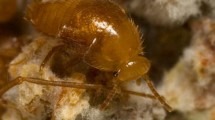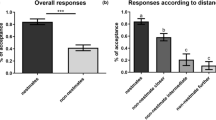Abstract
Colony-specific cuticular hydrocarbons are used by social insects in nestmate recognition. Here, we showed that hydrocarbons found on the mound of Pogonomyrmex barbatus nests facilitate the return of foragers to the nest. Colony-specific hydrocarbons, which ants use to distinguish nestmates from non-nestmates, are found on the midden pebbles placed on the nest mound. Midden hydrocarbons occur in a concentration gradient, growing stronger near the nest entrance, which is in the center of a 1–2 m diameter nest mound. Foraging behavior was disrupted when the gradient of hydrocarbons was altered experimentally. When midden material was diluted with artificial pebbles lacking the colony-specific hydrocarbons, the speed of returning foragers decreased significantly. The chemical environment of the nest mound contributes to the regulation of foraging behavior in harvester ants.





Similar content being viewed by others
References
Aron, S., Pasteels, J. M., and Deneubour, J. L. 1989. Trail-laying behavior during exploratory recruitment in the Argentine ant Iridomyrmex humilis mayr. Biol. Behav. 14:207–217.
Billen, J. 2009. Occurrence and structural organization of the exocrine glands in the legs of ants. Arthropod Struct. Develop. 38:2–15.
Brand, J. M., and Mpuru, S. P. 1993. Dufour's gland and poison gland chemistry of the myrmicine ant, Messor capensis (Mayr). J. Chem. Ecol. 19:1315–1321.
Cammaerts, R. and Cammaerts, M.C. 1987. Nest Topology, Nestmate recognition, territorial marking and homing in the ant Manica rubida (Hymenoptera, Formicidae). Biol. Behav. 12:65–81.
Cammaerts, M. C. and Rachidi, Z. 2009. Olfactive conditioning and use of visual and odorous cues for movement in the ant Myrmica sabuleti (Hymenoptera: Formicidae). Myrmecological News 12:117–127.
Co, J. E., Jones, T., Hefetz, A., Tinaut, A., and Snelling, R. 2003. The comparative exocrine chemistry of nine Old World species of Messor (Formicidae: Myrmicinae). Biochem. System. Ecol. 31:367–373.
D'ettorre, P. and Lenoir, A. 2010. Nestmate Recognition. pp. 194–209, in L. Lach, C. Parr and K. Abbott (eds.). Ant Ecology. Oxford University Press, USA.
Elston, W.E. et al., 1973. Tertiary Volcanic Rocks, Mogollon-Datil Province, New Mexico, and Surrounding Region: K-Ar Dates, Patterns of Eruption, and Periods of Mineralization. Geological Soc. Amer. Bull. 84:2259–2274.
Gordon, D. M. 1984a. Species-specific patterns in the social activities of harvester ant colonies (Pogonomyrmex). Insectes Sociaux 31:74–86.
Gordon, D.M. 1984b. Harvester ant middens: refuse or boundary? Ecological Entomology 9:403–412.
Gordon, D.M. 1986. The dynamics of the daily round of the harvester ant colony (Pogonomyrmex barbatus). An. Behav. 34:1402–1419.
Gordon, D.M. 1987. Group-level dynamics in harvester ants: young colonies and the role of patrolling. An. Behav. 35:833–843.
Gordon, D. M. 1991. Behavioral flexibility and the foraging ecology of seed-eating ants. Am. Nat. 138:379–411.
Gordon, D. M. 1992. How colony growth affects forager intrusion between neighboring harvester ant colonies. Behav. Ecol. Sociobiol. 31:417–427.
Gordon, D. M. and Kulig, A.W. 1996. Founding, foraging, and fighting: colony size and the spatial distribution of harvester ant nests. Ecology 77:2393–2409.
Gordon, D. M. and Mehdiabadi, N.J. 1999. Encounter rate and task allocation in harvester ants. Behav. Ecol. Sociobiol. 45:370–377.
Gordon, D. M. 2002. The regulation of foraging activity in red harvester ant colonies. Am. Nat. 159:509–518.
Gordon, D. M., Holmes, S., and Nacu, S. 2008. The short-term regulation of foraging in harvester ants. Behav. Ecol. 19:217–222.
Grasso, D. A., Sledge, M. F., Le Moli, F., Mori, A., and Turillazzi, S. 2005. Nest-area marking with faeces: a chemical signature that allows colony-level recognition in seed harvesting ants (Hymenoptera, Formicidae). Insectes Sociaux 52:36–44.
Greene, M. J. and Gordon, D.M. 2003. Social insects - Cuticular hydrocarbons inform task decisions. Nature 423:32.
Greene, M. J. and Gordon, D.M. 2007. How patrollers set foraging direction in harvester ants. Am. Nat. 170:943–948.
Hölldobler, B. 1971. Homing in the Harvester Ant Pogonomyrmex badius. Science 171:1149–1151.
Hölldobler, B., Morgan, E. D., Oldham, N. J., and Liebig, J. 2001. Recruitment pheromone in the harvester ant genus Pogonomyrmex. J. Insect Physiol. 47:369–374.
Jaffé, K., Ramos, C., Lagalla, C., and Parra, L. 1990. Orientation cues used by ants. Insectes Sociaux 37:101–115.
Lenoir, A., Depickere, S., Devers, S., Christides, J. P., and Detrain, C. 2009. Hydrocarbons in the ant Lasius niger: From the cuticle to the nest and home range marking. J. Chem. Ecol. 35:913–921.
Martin, S. J., Weihao, Z., and Drijfhout, F. P. 2009. Long-term stability of cuticular hydrocarbons facilitates chemotaxonomy using museum specimens. Biological Journal of the Linnean Society 96:732–737.
Schafer, R. J., Holmes, S., and Gordon, D. M. 2006. Forager activation and food availability in harvester ants. An. Behav. 71:815–822.
Singer, T. L. 1998. Roles of hydrocarbons in the recognition systems of insects. Am. Zoologist 38:394–405.
Soroker, V., Vienne, C. and Hefetz, A. 1995. Hydrocarbon dynamics within and between nestmates in Cataglyphis niger (Hymenoptera: Formicidae). Journal of Chemical Ecology, 21:365–378.
Soroker, V. and Hefetz, A. 2000. Hydrocarbon site of synthesis and circulation in the desert ant Cataglyphis niger. J. Insect Physiol. 46:1097–1102.
Soroker, V., Lucas, C., Simon, T., Fresneau, D., Durand, J. L., and Hefetz, A. 2003. Hydrocarbon distribution and colony odour homogenisation in Pachycondyla apicalis. Insectes Sociaux 50:212–217.
Steck, K., Hansson, B. S., and Knaden, M. 2009. Smells like home: Desert ants, Cataglyphis fortis, use olfactory landmarks to pinpoint the nest. Front. Zool. 6:5.
Steck, K., Knaden, M., and Hansson, B. S. 2010. Do desert ants smell the scenery in stereo? An. Behav. 79:939–945.
Tissot, M., Nelson, D. R., and Gordon, D. M. 2001. Qualitative and quantitative differences in cuticular hydrocarbons between laboratory and field colonies of Pogonomyrmex barbatus. Comp. Biochem. Physiol. B-Biochem. Molec. Biol. 130:349–358.
Tullio, A., Angelis, F., Reale, S., Grasso, D., Visicchio, R., Castracani, C., Mori, A., and Moli, F. 2003. Investigation by solid-phase microextraction and gas chromatography/mass spectrometry of trail pheromones in ants. Rapid Comm. Mass Spectrom. 17:2071–2074.
Vienne, C., Soroker, V., and Hefetz, A. 1995. Congruency of hydrocarbon patterns in heterospecific groups of ants: transfer and/or biosynthesis? Insectes Sociaux, 42:267–277.
Wagner, D., Brown, M., Broun, P., Cuevas, W., Moses, L., and Chao, D. 1998. Task-related differences in the cuticular hydrocarbon composition of harvester ants, Pogonomyrmex barbatus. J. Chem. Ecol. 24: 2021–2037.
Wagner, D., Tissot, M., Cuevas, W., and Gordon, D. M. 2000. Harvester ants utilize cuticular hydrocarbons in nestmate recognition. J. Chem. Ecol. 26:2245–2257.
Walsh, C.T., Law, J. H., and Wilson, E. O. 1965. Purification of fire ant trail substance. Nature 207:320&.
Wu, HJ. 1989. Home range orientation of the harvester ant Pogonomyrmex barbatus (Smith). Bull Ins Zool Acad Sin (Taipei) 28:87–96.
Zar, J. H. 1999. Biostatistical Analysis. 4th ed. pp. 278–279. Prentice Hall.
Acknowledgements
We thank Mattias Lanas for his technical assistance in the field. Many thanks to all the volunteers and staff at the Southwestern Research Station (SWRS) in Portal, AZ. Funding was provided by the Theodore Roosevelt Memorial Grant, the SWRS Student Support Fund, the NSF Graduate Research Fellowship, and NIH-NIDCD through a National Research Service Award (NRSA).
Author information
Authors and Affiliations
Corresponding author
Rights and permissions
About this article
Cite this article
Sturgis, S.J., Greene, M.J. & Gordon, D.M. Hydrocarbons on Harvester Ant (Pogonomyrmex barbatus) Middens Guide Foragers to the Nest. J Chem Ecol 37, 514–524 (2011). https://doi.org/10.1007/s10886-011-9947-y
Received:
Revised:
Accepted:
Published:
Issue Date:
DOI: https://doi.org/10.1007/s10886-011-9947-y




